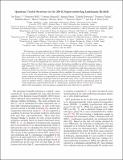Por favor, use este identificador para citar o enlazar a este item:
http://hdl.handle.net/10261/218538COMPARTIR / EXPORTAR:
 SHARE SHARE
 CORE
BASE CORE
BASE
|
|
| Visualizar otros formatos: MARC | Dublin Core | RDF | ORE | MODS | METS | DIDL | DATACITE | |

| Título: | Quantum crystal structure in the 250-kelvin superconducting lanthanum hydride |
Autor: | Errea, Ion CSIC ORCID; Belli, Francesco CSIC ORCID; Monacelli, Lorenzo; Sanna, Antonio; Koretsune, Takashi; Tadano, Terumasa; Bianco, Raffaello CSIC ORCID; Calandra, Matteo; Arita, Ryotaro; Mauri, Francesco; Flores-Livas, José A. | Fecha de publicación: | 2020 | Editor: | Springer Nature | Citación: | Nature volume 578: 66–69 (2020) | Resumen: | The discovery of superconductivity at 200 kelvin in the hydrogen sulfide system at high pressures demonstrated the potential of hydrogen-rich materials as high-temperature superconductors. Recent theoretical predictions of rare-earth hydrides with hydrogen cages and the subsequent synthesis of LaH10 with a superconducting critical temperature (Tc) of 250 kelvin have placed these materials on the verge of achieving the long-standing goal of room-temperature superconductivity. Electrical and X-ray diffraction measurements have revealed a weakly pressure-dependent Tc for LaH10 between 137 and 218 gigapascals in a structure that has a face-centred cubic arrangement of lanthanum atoms. Here we show that quantum atomic fluctuations stabilize a highly symmetrical Fm3¯¯¯m crystal structure over this pressure range. The structure is consistent with experimental findings and has a very large electron–phonon coupling constant of 3.5. Although ab initio classical calculations predict that this Fm3¯¯¯m structure undergoes distortion at pressures below 230 gigapascals, yielding a complex energy landscape, the inclusion of quantum effects suggests that it is the true ground-state structure. The agreement between the calculated and experimental Tc values further indicates that this phase is responsible for the superconductivity observed at 250 kelvin. The relevance of quantum fluctuations calls into question many of the crystal structure predictions that have been made for hydrides within a classical approach and that currently guide the experimental quest for room-temperature superconductivity. Furthermore, we find that quantum effects are crucial for the stabilization of solids with high electron–phonon coupling constants that could otherwise be destabilized by the large electron–phonon interaction9, thus reducing the pressures required for their synthesis. | Descripción: | arXiv:1907.11916v1 | Versión del editor: | https://doi.org/10.1038/s41586-020-1955-z | URI: | http://hdl.handle.net/10261/218538 | DOI: | 10.1038/s41586-020-1955-z | ISSN: | 0028-0836 | E-ISSN: | 1476-4687 |
| Aparece en las colecciones: | (CFM) Artículos |
Ficheros en este ítem:
| Fichero | Descripción | Tamaño | Formato | |
|---|---|---|---|---|
| quantuhydri.pdf | 3,58 MB | Adobe PDF |  Visualizar/Abrir |
CORE Recommender
SCOPUSTM
Citations
190
checked on 17-may-2024
WEB OF SCIENCETM
Citations
173
checked on 22-feb-2024
Page view(s)
108
checked on 16-may-2024
Download(s)
100
checked on 16-may-2024
Google ScholarTM
Check
Altmetric
Altmetric
NOTA: Los ítems de Digital.CSIC están protegidos por copyright, con todos los derechos reservados, a menos que se indique lo contrario.
